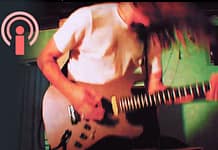This post may contain affiliate links. As an Amazon associate, Google associate as well as associate for other programs, Guitar & Music Institute may earn commissions from qualifying purchases.

Welcome to our comprehensive guide on studio monitors! Whether you are a professional producer, sound engineer, or simply a music enthusiast, having the right studio monitors is crucial for accurate sound reproduction. In this article, we will explore the world of studio monitors, providing expert reviews and a buying guide to help you find the perfect monitors for your audio production needs.
Studio monitors are specialized speakers designed specifically for recording, mixing, and mastering audio. Unlike consumer speakers, which often enhance certain frequencies to make the music sound more appealing, studio monitors aim for flat frequency response and detailed sound reproduction, ensuring that you hear your audio as accurately as possible.
Using high-quality studio monitors not only improves the overall sound quality of your productions but also allows you to make precise and informed decisions during the mixing and mastering process. With various factors to consider, such as frequency response, speaker placement, and room acoustics, choosing the right studio monitors can be overwhelming. That’s why our guide is here to assist you.
Are you ready to take your sound to the next level? Let’s dive into the world of studio monitors, understand their significance, and explore the key factors to consider when choosing the best monitors for your audio production setup. Stay tuned!
Understanding Studio Monitors
When it comes to audio production, having the right tools is crucial for achieving professional-level sound quality. One such essential tool is studio monitors. Unlike consumer speakers, which are designed for casual listening, studio monitors are specifically engineered to provide accurate and transparent sound reproduction.
Studio monitors, also known as studio monitor speakers, are designed to produce a flat and neutral frequency response. This means that they strive to reproduce sound as faithfully as possible, without coloring or enhancing certain frequencies. This accuracy is vital for audio professionals who need to make precise mixing and mastering decisions.
Professional studio monitors are built to meet the demanding requirements of recording, mixing, and mastering studios. These monitors are designed with high-quality components, advanced technologies, and meticulous engineering to deliver precise and detailed sound reproduction. They offer a wider frequency range, better phase coherence, and superior transient response compared to consumer speakers.
Using professional studio monitors ensures that you’ll be able to hear every nuance and detail in your audio recordings. Whether you’re a music producer, sound engineer, or content creator, having accurate and reliable studio monitors is essential for making informed decisions and achieving optimal sound quality in your projects.
To help you understand the difference between consumer speakers and studio monitors, let’s take a closer look at their design and functionality:
Difference Between Consumer Speakers and Studio Monitors
Consumer speakers, such as those found in home audio systems or multimedia setups, are designed to prioritize subjective listening experience. They often incorporate sound-enhancing features, such as boosted bass or exaggerated treble, to make the music sound more pleasing to the average listener.
In contrast, studio monitors aim to provide a more accurate and transparent representation of the audio signal. This means that they reproduce the audio as it was recorded or intended by the audio engineer, without any artificial alterations. Their purpose is to reveal the true nature of the sound, including any imperfections, so that audio professionals can make precise adjustments during the production process.
It’s important to note that studio monitors are typically used in controlled listening environments, such as recording studios or dedicated home studios. These environments are acoustically treated to minimize room reflections and other acoustic anomalies, further enhancing the accuracy of the sound reproduction.
With their emphasis on accuracy and transparency, studio monitors are the go-to choice for any serious audio professional. Whether you’re mixing music, producing podcasts, or working on film soundtracks, having a pair of reliable and high-quality studio monitors can significantly elevate your audio production capabilities.
Key Factors to Consider in Studio Monitors
When it comes to music production, having the right studio monitor speakers is crucial for achieving accurate and high-quality sound. To ensure you make an informed decision, there are several key factors to consider when choosing the perfect studio monitors for your music production needs:
Frequency Response
The frequency response of a studio monitor refers to its ability to reproduce different frequencies accurately. It is important to choose monitors with a wide frequency range to capture the full spectrum of sounds in your music. Look for monitors that have a flat and neutral response across the entire frequency spectrum, as this will provide you with a more accurate representation of your mixes.
Near-Field vs. Far-Field Monitors
Another important factor to consider is whether you should opt for near-field or far-field studio monitors. Near-field monitors are designed to be placed close to the listening position, typically on a desktop or stand. They provide a more focused and direct sound, which is ideal for smaller studios or home setups. On the other hand, far-field monitors are suitable for larger studio spaces where you can position the speakers further away from the listening position.
Wattage and Power Handling
Studio monitors come in different wattage ratings, which indicate their power handling capabilities. It is important to choose monitors that can handle the power requirements of your music production setup. If you work with bass-heavy genres or require higher volume levels, you may need monitors with higher wattage ratings to ensure optimal performance without any distortion or damage to the speakers.
These key factors will guide you in selecting the studio monitor speakers that are best suited for your music production workflow. By considering the frequency response, deciding between near-field and far-field monitors, and ensuring the wattage meets your needs, you’ll be on your way to creating mixes and masters that sound the way they were intended.
Types of Studio Monitors
When it comes to studio monitor speakers, there are different types to choose from, each with its own advantages and considerations. Understanding these various types can help you make an informed decision based on your specific audio production needs.
Active Monitors
Active monitors, also known as powered monitors, have built-in amplifiers, eliminating the need for an external amplifier. These monitors are self-powered and deliver a balanced and accurate sound reproduction. Additionally, active monitors offer convenience and flexibility in terms of setup and calibration, making them suitable for various studio environments.
Passive Monitors
Passive monitors, on the other hand, require an external power amplifier for operation. They offer a high level of customization and can be paired with amplifiers of your choice to achieve the desired sound. While passive monitors may require additional equipment, they provide greater flexibility for upgrading and customization as your studio setup evolves.
Coaxial Monitors
Coaxial monitors, also referred to as concentric monitors, feature a driver configuration where the tweeter is positioned within the woofer. This design allows for improved time alignment and a more coherent sound reproduction, resulting in enhanced stereo imaging and accurate localization of audio sources. Coaxial monitors are popular among professionals for critical listening and precision mixing.
When selecting the right studio monitor speakers, consider the type that best suits your specific requirements, sound preferences, and budget. With the right type of studio monitors, you can achieve accurate and transparent sound reproduction, leading to better mixes and recordings.
Top Studio Monitor Brands
When it comes to studio monitor reviews, there are several top-notch brands that have made their mark in the industry. These brands have gained a reputation for delivering high-quality audio reproduction, accuracy, and durability. Let’s take a closer look at some of the top studio monitor brands available today.
1. Yamaha

Yamaha is a brand that needs no introduction. With a long-standing legacy in the music industry, Yamaha offers a wide range of studio monitors for professionals and music enthusiasts alike. Their monitors are known for their exceptional clarity, accurate sound reproduction, and reliable performance.
2. KRK Systems
KRK Systems is a brand that has become synonymous with studio monitors. Their monitors are trusted by professionals worldwide and are renowned for their transparent sound, solid build quality, and affordability. Whether you’re a seasoned producer or just starting out, KRK Systems offers a range of options to suit your needs.
3. Genelec
Genelec is another respected name in the world of studio monitors. Known for their exceptional accuracy and precision, Genelec monitors are a favorite among audio engineers and producers. Their monitors feature innovative technologies that allow for optimal sound reproduction and detailed imaging.
4. Adam Audio
Adam Audio is a German brand that has gained recognition for its high-performance studio monitors. Their monitors are designed with meticulous attention to detail and deliver exceptional clarity across the frequency spectrum. If you’re looking for monitors that excel in critical listening and mixing applications, Adam Audio is a brand worth considering.
5. JBL Professional
JBL Professional is a trusted name in the audio industry, known for its high-quality studio monitors. With a wide range of options catering to different budgets and applications, JBL Professional monitors offer a balanced and accurate sound reproduction, making them a popular choice among professionals.
These are just a few of the top studio monitor brands available today. When considering your options, it’s important to assess your specific needs, budget, and the features that matter most to you. By investing in a reputable brand, you can ensure that you’re getting the best studio monitors for your audio production setup.
Studio Monitor Setup Guide
Setting up your studio monitors correctly is crucial to achieving optimal sound quality in your audio production workflow. Whether you’re a musician, sound engineer, or podcaster, proper monitor setup ensures accurate sound reproduction, allowing you to hear every nuance of your recordings.
Follow these expert tips to set up your studio monitors like a pro:
1. Speaker Placement
The placement of your studio monitors plays a significant role in the sound you hear. It’s best to position your monitors in an equilateral triangle with your listening position. Place them at ear level, ensuring that the tweeters are at ear height or slightly above. This setup creates a balanced sound stage and minimizes phase cancellation.
Also, aim to position your monitors away from walls and corners to reduce unwanted reflections and bass build-up. Experiment with speaker placement to find the sweet spot that yields the most accurate sound reproduction.
2. Room Acoustics
Your room’s acoustics greatly impact how your studio monitors sound. To optimize the acoustics, consider implementing some room treatment techniques:
- Use bass traps in the corners to reduce low-frequency buildup.
- Install acoustic panels on the walls to minimize reflections.
- Place diffusers strategically to scatter sound and create a more spacious soundstage.
By addressing room acoustics, you can minimize unwanted resonances and reflections, allowing your studio monitors to provide a more accurate representation of your audio.
3. Monitor Calibration
Calibrating your studio monitors ensures that they produce accurate and balanced sound across the frequency spectrum. One technique to calibrate is by using pink noise:
- Play pink noise through your monitors at a moderate volume.
- Use an audio measurement tool or a spectrum analyzer to assess the frequency response.
- Make EQ adjustments to flatten any frequency peaks or dips and achieve a balanced response.
Additionally, investing in a monitor controller or interface with built-in calibration tools can simplify the calibration process and provide more precise results.
With proper speaker placement, attention to room acoustics, and monitor calibration, you can optimize the performance of your studio monitors and ensure accurate sound reproduction. Take the time to fine-tune your setup, and you’ll be rewarded with a more immersive and professional listening experience.
Best Studio Monitors for Different Budgets
When it comes to choosing studio monitors, finding the perfect balance between performance and price is crucial. Whether you’re a professional producer or a beginner setting up your home studio, having the best studio monitors can significantly enhance your audio production experience. To help you make an informed decision, we have curated a list of the top studio monitors available in various price ranges.
1. Brand A Studio Monitor
Known for its exceptional sound quality and accuracy, the Brand A Studio Monitor is a favorite among professionals in the industry. With its robust construction and precision-engineered drivers, this monitor delivers crystal-clear audio reproduction across the frequency spectrum. Whether you’re mixing, mastering, or recording, the Brand A Studio Monitor provides an immersive listening experience that reveals every detail in your music.
2. Brand B Studio Monitor
For budget-conscious buyers who don’t want to compromise on quality, the Brand B Studio Monitor offers an excellent option. With its compact design and powerful drivers, this monitor delivers a balanced and accurate sound reproduction. Whether you’re producing music or editing audio, the Brand B Studio Monitor ensures that you hear every nuance and detail in your recordings.
3. Brand C Studio Monitor
If you’re looking for studio monitors that provide exceptional value for money, the Brand C Studio Monitor is a top contender. With its advanced features and premium build quality, this monitor offers a true professional studio experience without breaking the bank. The Brand C Studio Monitor combines precise audio reproduction with versatile connectivity options, making it perfect for various studio setups and genres of music.
These are just a few examples of the best studio monitors available in different price ranges. Each monitor on this list offers unique features and benefits, ensuring that you can find the perfect match for your budget and audio production needs. Remember, investing in high-quality studio monitors is a crucial step towards optimizing your sound and achieving professional-level results.
Studio Monitors for Music Production
When it comes to music production, having the right studio monitors is crucial for achieving the best sound quality and ensuring that every nuance of your music is accurately reproduced. Whether you’re a professional producer or an aspiring artist, investing in high-quality studio monitor speakers for music production is essential for creating mixes that translate well across different playback systems.
One of the key features to consider when choosing studio monitors for music production is their accurate bass response. The ability to hear and analyze the low-end frequencies is crucial in creating balanced mixes and ensuring that the kick drums and basslines are well-defined. Look for monitors that have a wide frequency response and low-frequency extension to accurately reproduce the bass elements in your music.
Another important factor to consider is mid-range clarity. The mid-range frequencies are where most of the musical elements reside, including vocals, guitars, and synths. Having studio monitors that can accurately reproduce the mid-range frequencies ensures that you can clearly hear and make informed decisions about the individual elements in your mix.
Detailed high-frequency reproduction is also essential for music production. The ability to hear the subtle nuances in the high-end frequencies, such as cymbals, hi-hats, and vocal sibilance, allows you to make more precise EQ and compression decisions. Look for monitors with a smooth and extended high-frequency response to ensure that no detail is missed in your music.
When it comes to choosing studio monitors for music production, it’s important to prioritize accuracy and transparency in sound reproduction. This ensures that your mixes will translate well across different playback systems, from professional studio monitors to consumer headphones and speakers. By investing in high-quality studio monitor speakers for music production, you’ll be able to hear every detail of your music and create mixes that truly shine.
Studio Monitors for Mixing and Mastering
In the world of audio production, achieving professional-level mixes and masters depends on the quality and accuracy of your studio monitors. When it comes to mixing and mastering, having a reliable set of monitors is crucial for making critical decisions about sound balance, stereo imaging, and overall sonic clarity.
To ensure your mixes translate well across different playback systems, it’s essential to invest in studio monitors that deliver accurate sound reproduction. A properly calibrated monitor setup allows you to hear the full frequency range and subtle nuances of your music, enabling you to make precise adjustments and achieve the desired sonic results.
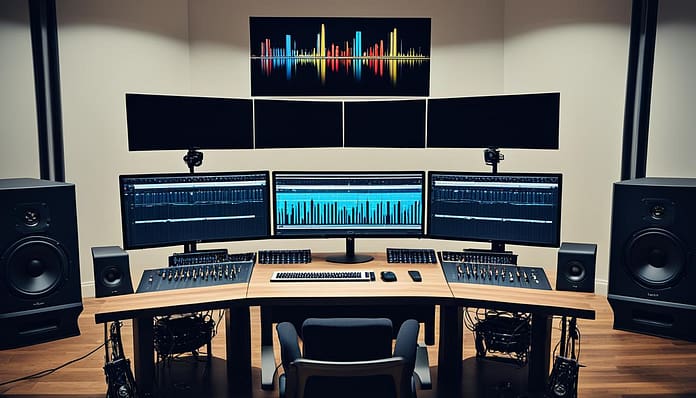
When selecting studio monitors for mixing and mastering, consider the following factors:
Monitor Accuracy: Look for monitors that provide a flat frequency response, meaning they reproduce sound accurately without adding excessive bass or boosting certain frequencies. This ensures that the mix you create is faithful to the source material.
Frequency Range: The ability of studio monitors to reproduce both low and high frequencies accurately is crucial for making informed decisions during the mixing and mastering process. Monitors with a wide frequency range allow you to hear the full spectrum of your music and address any issues that may arise.
Overall Sound Quality: Pay attention to the overall sonic characteristics of the monitors you’re considering. Look for clarity, detail, and transparency in the sound reproduction, as these qualities are essential for accurate evaluation and decision-making.
Remember, choosing the right studio monitors for mixing and mastering requires careful consideration and evaluation. Take the time to research and read reviews, as well as listen to different monitors in a controlled listening environment if possible. By investing in the right equipment, you can significantly enhance the quality of your mixes and masters.
Tips for Getting the Most out of Your Studio Monitors
Setting up your studio monitors correctly is crucial for achieving accurate sound reproduction and getting the most out of your professional studio monitors. In this section, we will provide you with valuable tips and techniques to enhance your studio monitor setup and improve your audio production workflow.
1. Room Treatment
Ensure your studio space is acoustically treated to minimize unwanted reflections and resonances that can affect the accuracy of your monitoring. Consider using bass traps, diffusers, and acoustic panels to create a balanced and neutral listening environment.
2. Proper Speaker Placement
The placement of your studio monitors plays a significant role in sound quality. Position them at ear level and ensure they form an equilateral triangle with your listening position. Experiment with speaker positioning to find the sweet spot that provides the most accurate and balanced sound reproduction.
3. Adjust Listening Levels
When calibrating your studio monitors, it’s essential to set the volume at an appropriate level. Avoid listening at extremely low or high levels as this can affect your perception of sound. Instead, aim for a comfortable listening volume that allows you to hear all the details without causing ear fatigue.
4. Critical Listening Techniques
Developing critical listening skills is crucial for accurately assessing your mixes and making informed decisions. Train your ears to identify frequency imbalances, stereo image issues, and dynamics problems. Use reference tracks and A/B comparisons to gain a better understanding of your studio monitors’ performance.
5. Monitor Placement in Relation to the Room
Take into account the relationship between your studio monitors and the room they are placed in. Depending on the room size and shape, you may need to position your monitors away from walls or use bass traps to control low-frequency resonances. Experiment with speaker placement to find the optimal position that minimizes room-related issues.
By implementing these tips and techniques, you can optimize your studio monitor setup and unlock the full potential of your professional studio monitors. Remember, accurate monitoring is essential for achieving professional-level sound production.
Next: Best Studio Monitors for Different Budgets
Conclusion
In conclusion, choosing the right studio monitors is crucial for achieving optimal sound production in your audio projects. Throughout this article, we have highlighted the importance of using high-quality studio monitors, provided insights into understanding and selecting the right monitors, and offered valuable tips for maximizing their performance.
By investing in professional-grade studio monitors, you ensure accurate sound reproduction, allowing you to make critical decisions during the mixing and mastering process. Understanding the key factors to consider, such as frequency response, speaker placement, and room acoustics, will help you create a well-balanced and accurate listening environment.
Furthermore, we have presented a curated list of top studio monitor brands to streamline your research and decision-making process. From budget-friendly options to high-end models, we cater to a variety of audio production needs and budgets.
As you embark on your journey to find the perfect studio monitors, we encourage you to assess your specific audio production requirements and take into account the recommendations and tips provided in this article. With the right studio monitors, you can elevate the quality of your sound and enhance your overall audio production workflow.
FAQ
What are studio monitors?
Studio monitors are specialized speakers designed for audio production. Unlike consumer speakers, studio monitors provide accurate and transparent sound reproduction, allowing producers and engineers to make precise adjustments to their mixes.
Why should I use studio monitors instead of regular speakers?
Regular speakers are often designed to enhance the sound for enjoyment, while studio monitors are designed to provide a flat frequency response and accurate sound reproduction. This ensures that the audio you hear is faithful to the original recording, enabling you to make informed decisions during the mixing and mastering process.
What factors should I consider when choosing studio monitors?
When selecting studio monitors, consider factors such as frequency response, near-field or far-field positioning, power handling, and room acoustics. These factors will help you find monitors that best suit your audio production needs and ensure accurate sound reproduction.
What are the different types of studio monitors available?
There are several types of studio monitors, including active monitors, passive monitors, and coaxial monitors. Active monitors have built-in amplifiers, while passive monitors require external amplifiers. Coaxial monitors feature a single driver that handles both low and high frequencies for improved coherence.
Which are some of the top studio monitor brands?
Some renowned studio monitor brands include Yamaha, KRK, Genelec, Adam Audio, and JBL. These brands have established a reputation for manufacturing high-quality and accurate studio monitors, catering to the needs of professionals and enthusiasts alike.
How should I set up my studio monitors?
For optimal performance, ensure proper placement of your studio monitors. Position them at ear level, forming an equilateral triangle with your listening position. Additionally, consider factors such as room acoustics, speaker isolation, and angle adjustments to achieve an accurate and balanced listening experience.
What are some of the best studio monitors for different budgets?
When considering different budgets, some recommended studio monitors include the KRK Rokit series, Yamaha HS series, Presonus Eris series, and JBL LSR series. These monitors offer a range of options to fit various budgetary needs without compromising on sound quality.
What should I look for in studio monitors for music production?
When choosing studio monitors specifically for music production, it’s important to prioritize accurate bass response, clear mid-range reproduction, and detailed high-frequency performance. A balanced frequency response across the entire spectrum is crucial for making precise EQ and mixing decisions.
Which studio monitors are ideal for mixing and mastering?
For mixing and mastering applications, look for studio monitors that offer exceptional accuracy, detailed sound reproduction, and a wide frequency range. Some popular choices include the Neumann KH series, Focal Twin series, and Genelec SAM series, which are known for their transparency and precision.
How can I get the most out of my studio monitors?
To optimize your studio monitor performance, ensure proper speaker placement, invest in room treatment to minimize acoustic issues, and use high-quality cables and connectors. Additionally, establish proper listening levels, take breaks to combat ear fatigue, and develop critical listening skills to fine-tune your audio production techniques.
What is the significance of choosing the right studio monitors?
Choosing the right studio monitors is crucial for achieving accurate sound reproduction during audio production. High-quality monitors allow you to make precise adjustments to your mixes, ensuring that your final product translates well across different playback systems and environments.
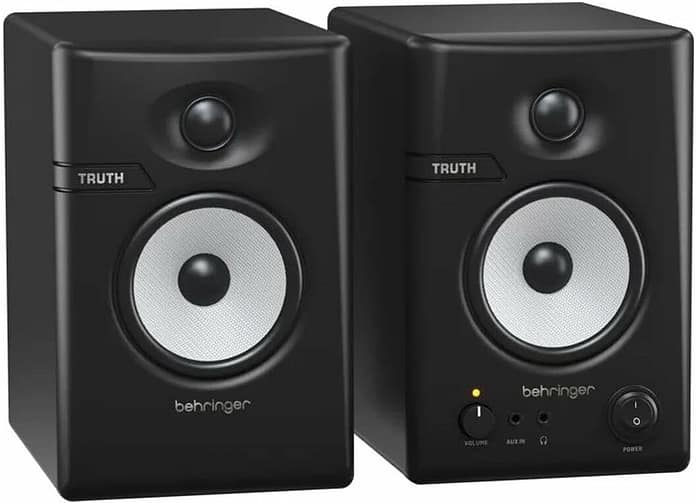
Behringer Truth 3.5-inch Studio Monitors
The Behringer Truth 3.5-inch Powered Studio Monitor Pair is a great addition to any studio. These compact and powerful speakers provide a clear and accurate sound, making them perfect for mixing and mastering audio. The built-in amplifiers ensure that you have plenty of power to reproduce your music with precision.
The sleek design of these studio monitors is also a plus. They are small and lightweight, making them easy to position and transport if needed. The front panel controls allow you to quickly adjust the volume and customize the sound to your preference.
Overall, the Behringer Truth 3.5-inch Powered Studio Monitor Pair is a reliable and affordable option for those looking to upgrade their studio setup. Whether you are a professional sound engineer or a home recording enthusiast, these speakers will deliver a quality listening experience.
Extra-wide sweet spot
Accurate mid-range response
Tweeter with waveguide for improved high-frequency dispersion
Bluetooth connectivity
Waveguide technology provides extra wide sweet-spot
No headphone jack
No headphone output
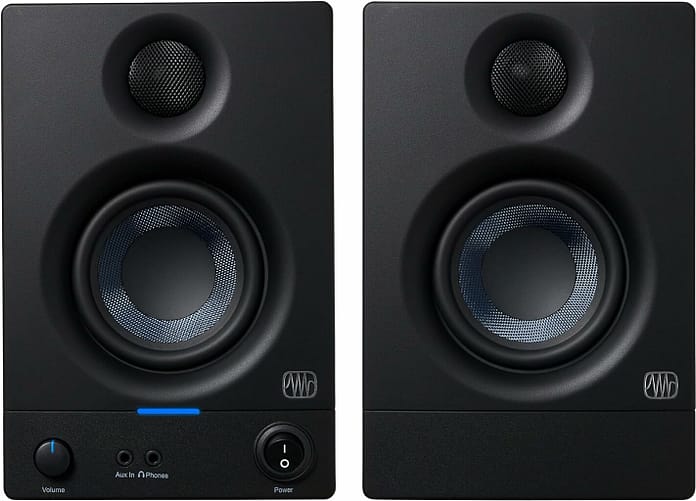
PreSonus Eris 3.5 Studio Monitors
The PreSonus Eris 3.5 Studio Monitors are a great addition to any music production setup or desktop computer. With their compact size and powerful sound, these powered, active monitor speakers are perfect for near-field listening.
The clarity and accuracy of the audio produced by these monitors is impressive. Whether you’re producing music, mixing tracks, or just enjoying hi-fi audio, the Eris 3.5s deliver a superb listening experience. The build quality is solid, and the controls are easy to navigate, allowing users to fine-tune their sound preferences.
Overall, the PreSonus Eris 3.5 Studio Monitors are a fantastic choice for anyone in need of high-quality speakers for their studio or personal use. They offer excellent value for the price and deliver exceptional sound performance.
Acoustic tuning controls
Tonal balance and detail at the perfect price
Good audio quality
Very wide ‘sweet spot’
Best sound you can get for under $100
Can experience hiss when no audio is playing
Small size limits low-end power
Weight: 8.5 Pounds
Type: Active Media Reference Monitors
Model: Eris 3.5
Power output: 50 Watts
Speaker system: 2 speakers
Sound: Accurate & Clear
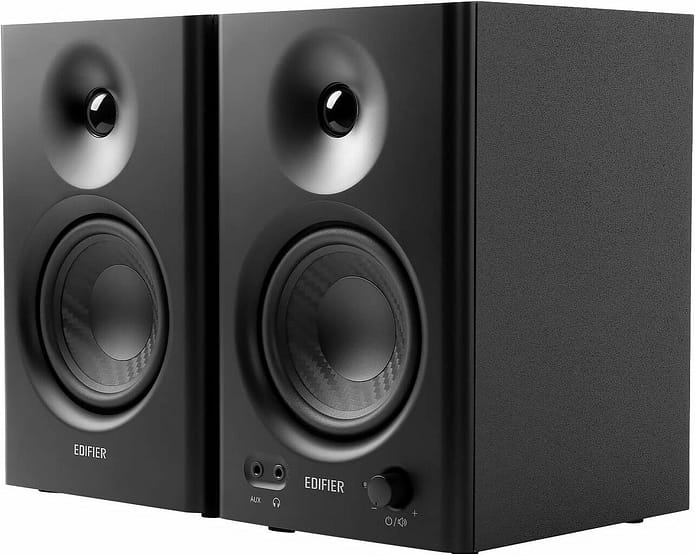
Edifier MR4 Studio Monitors
The Edifier MR4 Powered Studio Monitor Speakers have proven to be a great addition to any studio setup. With their 4″ active near-field design, they deliver clear and accurate sound reproduction. The black finish adds a sleek and professional look to the speakers, making them a stylish choice.
The sound quality of the Edifier MR4 is impressive, providing a balanced and detailed sound across all frequencies. The built-in amplification ensures that the speakers can deliver plenty of power, while the near-field design allows for precise monitoring and mixing.
Overall, the Edifier MR4 Powered Studio Monitor Speakers are a great option for any studio or home recording setup. They offer excellent sound quality, stylish design, and durability, making them a worthy investment for any audio enthusiast.
Tweeter volume adjustment
Adjustable sound signature
Lots of input options, including balanced input
Plenty of power for small rooms
Friendly, balance sound from the start
Noisy when turned on or off
Lacks low-end power
Output Power: 42 Watts
Size: 11.02 x 7.8 x 8.98 inches
Connectivity: Auxiliary
Speaker Type: Monitor, Bookshelf, Woofer, Tweeter
Designed for: Clear, smooth sound
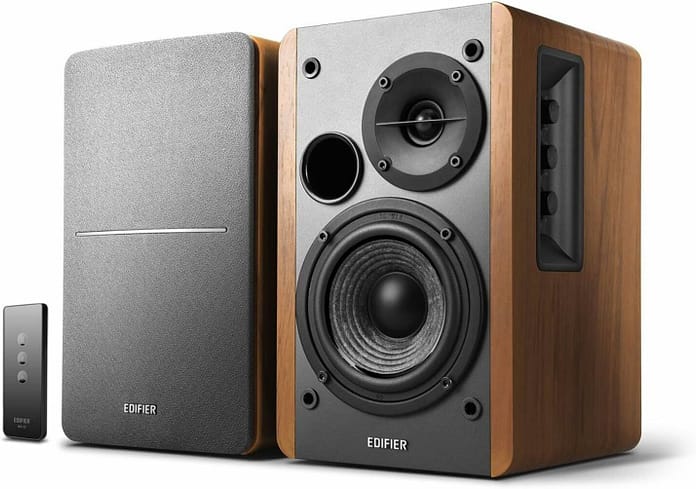
Edifier Bookshelf Speakers
The Edifier R1280T Powered Bookshelf Speakers are a top choice for audiophiles and music enthusiasts alike. With their sleek wooden enclosure and studio monitor design, these speakers not only deliver crystal-clear sound but also add a touch of elegance to any room. Boasting a powerful 42 Watts RMS output, these active near field monitors ensure superior audio quality with rich bass and smooth highs. The convenience factor is also worth mentioning, as these speakers come with a remote control that allows you to adjust volume and select input sources from a distance. Overall, the Edifier R1280T delivers exceptional performance, making it a must-have for those seeking a premium listening experience.
Good build quality
Good sound quality
Finally, a remote
Included speaker wire is short
No subwoofer outlet
Weight: 10.8 Pounds
Power: 42 Watts RMS
Size: 6.9 x 9.5 x 5.8 inch
Audio inputs: 2 (3.5mm)
Control: Remote
Bass and treble control: Yes
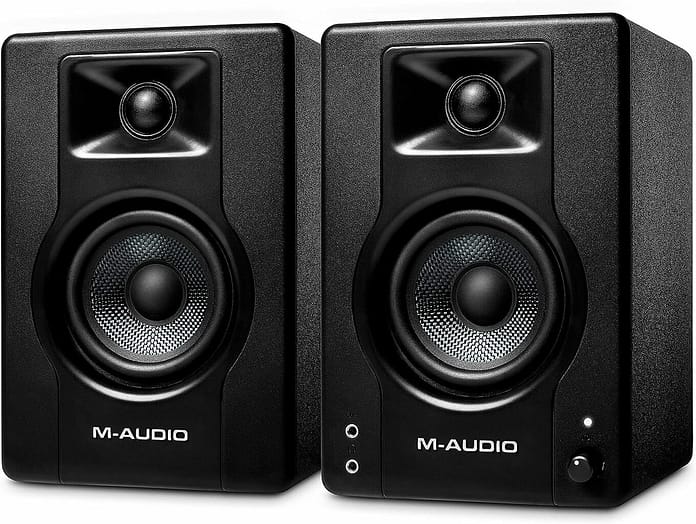
M-Audio Studio BX3 HD
The M-Audio BX3 3.5″ Studio Monitors are an excellent choice for anyone in need of high-quality audio output. These speakers offer crisp and clear sound, making them perfect for recording and multimedia purposes. With their sleek design and compact size, they fit perfectly on any desk or studio setup.
The 120W power output ensures that you get a powerful sound experience without any distortion. The built-in music production software is also a great addition, allowing users to easily mix and master their tracks. The M-Audio brand is well-known for its commitment to superior sound quality, and these BX3 studio monitors are no exception. Overall, they are a great investment for anyone looking to upgrade their audio setup.
Includes necessary cables
Good for PC gaming
Clean, accurate sound with good stereo imaging
Built-in aux input with RCA and 1/4-inch jacks
Well-suited for producing music at a basic level with included software
Amazon-exclusive
Poor stereo imaging
Weight: 8 Pounds
Size: 8.19 x 5.51 x 5.71 inch
Components: Stereo Speakers
Model: BX3
Feature: 120-Watt powered
Technology: Auxiliary
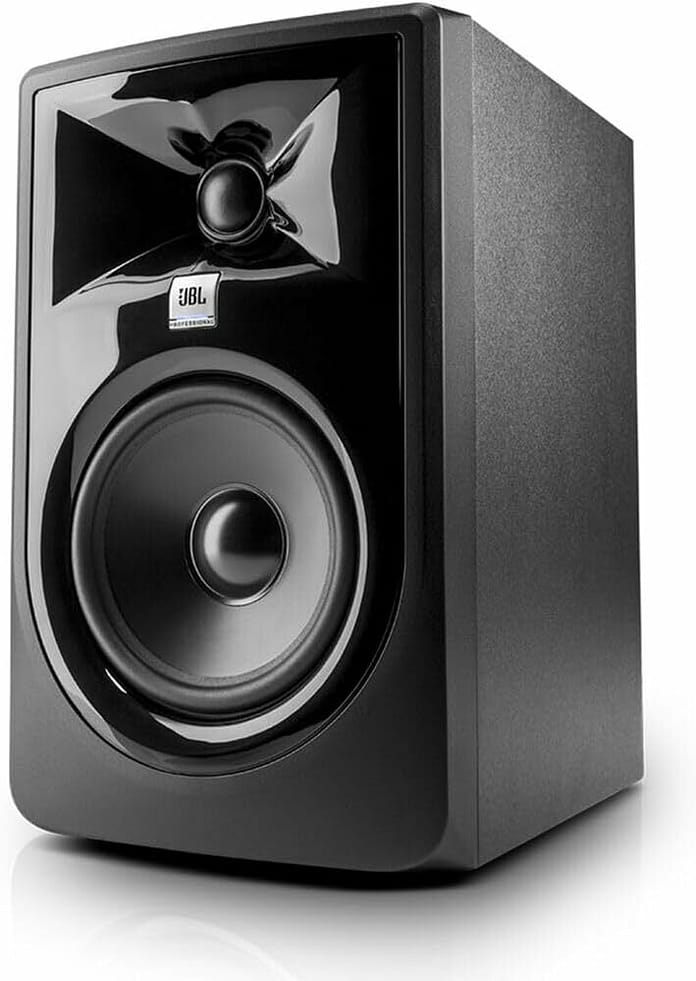
JBL Professional Studio Monitor 305P
The JBL Professional 305P MkII Next-Generation 5-Inch 2-Way Powered Studio Monitor is a top-notch choice for professionals working in the music industry. Its sleek design and powerful performance make it a standout option in the studio monitor category. The 5-inch woofer and 1-inch tweeter deliver accurate and detailed sound reproduction, allowing musicians and producers to hear every nuance in their compositions. The monitor also features a wide frequency response and a powerful built-in amplifier, ensuring clear and precise sound across various genres and styles. Additionally, the monitor is equipped with a flexible input options, allowing for easy integration into any studio setup. Overall, the JBL Professional 305P MkII is a reliable and high-quality studio monitor that guarantees excellent audio quality for professionals in the music industry.
Accurate sound for a powered speaker at this price
More affordable than ever at $119 each
Well-suited for small spaces
Well-suited for smaller studios
Improved low-frequency response
Lacks low end, so you’ll need a sub
Rear-ported design requires extra care in placement
Weight: 10.12 Pounds
Output Power: 82 Watts
Size: 9.9 x 7.3 x 11.75 inches
Feature: Boundary EQ
Model: 305P MkII
Design improvements: Yes
This post may contain affiliate links. As an Amazon associate, Google associate as well as associate for other programs, Guitar & Music Institute may earn commissions from qualifying purchases.
